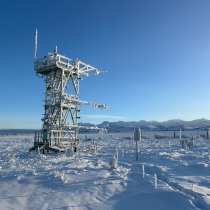Data Notification
Data Impacts for NEON's Yellowstone Sites (YELL, BLDE) due to Catastrophic Flooding
August 30, 2022
On June 12, 2022, catastrophic flooding of the Gardiner and Yellowstone Rivers across southern Montana and northern Wyoming caused by late season snowfall and heavy precipitation resulted in the closure of Yellowstone National Park (YNP). Heavy damage to roads and other infrastructure was sustained within the northern portion of YNP and its gateway communities of Gardiner, MT, and Cooke City, MT.
Consequently, NEON staff have been unable to access the terrestrial YELL and aquatic BLDE sites, both of which are located in the northern portion of the Park. While much of the sensor infrastructure has continued to collect data, all planned Terrestrial Observation Sampling (TOS) and Aquatic Observation Sampling (AOS) have been cancelled in Domain 12 since June 12, 2022.
We continue to closely coordinate with Park staff, and we are hopeful that some key road repairs will be completed by mid-October. If successful, these repairs would allow NEON staff to return to YELL and BLDE for regular Instrument System maintenance activities and limited TOS & AOS sampling. In the interim, we are conducting very limited activities by accessing the sites through the western part of the Park, facing significantly increased travel times and reduced lodging availability. Please see below for additional details, and we will provide an update to this notification once we are able to resume regular site visits.
Terrestrial and Aquatic Observation System (TOS and AOS) Data Impacts
We expect to collect Vegetation structure measurements at a subset of tower plots from late August through September 2022. All other TOS sampling for 2022 has been cancelled since snowfall is expected to resume as roads are repaired.
We expect to perform a subset of AOS activities such as Surface water chemistry and Surface water microbes from mid-October through the rest of 2022. Stream discharge will be performed while surface ice conditions are suitable, which we expect to be mid-October through November 2022. All other AOS sampling for 2022 has been cancelled.
Terrestrial and Aquatic Instrument System (TIS and AIS) Data Impacts
The immediate impact of the Yellowstone flood on NEON instrumentation was approximately 30 hours of missed data due to a widespread power outage. The subsequent inability to access the field sites has had an ongoing impact, including missed calibrations, delays in replacing damaged sensors/cables, and sensors not being cleaned and maintained on a regular basis.
For the Aquatic instruments in particular, the inaccessibility of the Blacktail Deer Creek field site has prevented NEON Field Ecologists from calibrating the SUNA (nitrate sensor) and the Sondes (water quality sensors). SUNA and pH data missed scheduled calibrations on July 1, and conductivity, turbidity, dissolved organic matter, and dissolved oxygen measurements missed calibrations on August 1. Field Ecologists were able to do a corrective maintenance and site assessment visit on August 8 and found significant debris creating dams on NEON infrastructure. This debris was removed, and the support structures held with minimal damage from the flood, with sensor failures discovered only for a datalogger, a temperature sensor, the SUNA cable, and the pressure sensor measuring water level at groundwater well 7. Due to time constraints, the SUNA and Sondes were not calibrated. We anticipate calibration in mid-October 2022.
Not being subject to the direct flood forces, the biggest impacts to the YELL flux tower were due to the extended absence of Field Ecologists and the resulting lack of maintenance. The flood occurred while the Yellowstone Tower was inaccessible for maintenance due to a Bear Management Area closure, which takes place annually from March 10 to June 30. Wet Deposition measurements were suspended as usual for the closure, but these measurements were not restarted as scheduled in early July. They will remain suspended until regular access to the site is restored. Maintenance that was delayed due to the annual closure was further delayed until August, when technicians and ecologists were able to return to the tower for limited visits.
During this extended closure, several instruments failed that could not be repaired in the planned timeframe, resulting in no data from the tower top photosynthetically active radiation sensors and aspirated temperature sensors. The CIMEL sun photometer failed and was not replaced until August. In the soil plots, there were several failures of soil CO2, soil moisture, and soil temperature sensors. A failure of a rotary vane pump led to LI-850 infrared gas analyzer measurements going offline, and a syringe failure resulted in a loss of validations for the Picarro H2O sensor.
These issues were resolved by field visits by NEON staff during the weeks of August 8 and August 22. As no maintenance has been possible outside of these visits, sensors have not been cleaned and desiccants have not been replaced on a regular basis. The inability to access the instrumentation sites to preventatively clean sensors, replace gas inlet filters, and recharge desiccants may result in further failures that may not be resolvable until regular access is restored.

